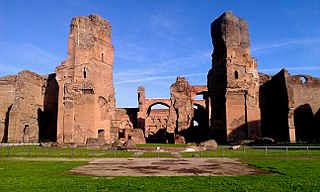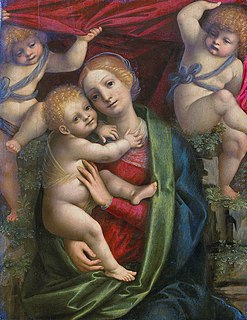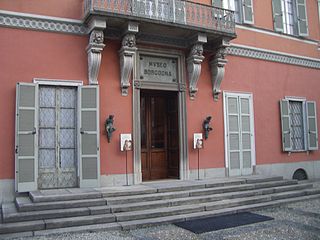Related Research Articles

The Vatican Museums are the public museums of the Vatican City. They display works from the immense collection amassed by the Catholic Church and the papacy throughout the centuries, including several of the most renowned Roman sculptures and most important masterpieces of Renaissance art in the world. The museums contain roughly 70,000 works, of which 20,000 are on display, and currently employ 640 people who work in 40 different administrative, scholarly, and restoration departments.

The Baths of Caracalla in Rome, Italy, were the city's second largest Roman public baths, or thermae, after the Baths of Diocletian. The baths were likely built between AD 212 and 216/217, during the reigns of emperors Septimius Severus and Caracalla. They were in operation until the 530s and then fell into disuse and ruin.

Guido Reni was an Italian painter of the Baroque period, although his works showed a classical manner, similar to Simon Vouet, Nicolas Poussin, and Philippe de Champaigne. He painted primarily religious works, but also mythological and allegorical subjects. Active in Rome, Naples, and his native Bologna, he became the dominant figure in the Bolognese School that emerged under the influence of the Carracci.

Vercelli, is a city and comune of 46,552 inhabitants in the Province of Vercelli, Piedmont, northern Italy. One of the oldest urban sites in northern Italy, it was founded, according to most historians, around 600 BC.

Giacomo Raffaelli was an Italian mosaicist from Rome. He is the author of a copy of Leonardo da Vinci's Last Supper commissioned by Napoleon I. The mosaic resides at Vienna in the Minoritenkirche.

Gino Severini was an Italian painter and a leading member of the Futurist movement. For much of his life he divided his time between Paris and Rome. He was associated with neo-classicism and the "return to order" in the decade after the First World War. During his career he worked in a variety of media, including mosaic and fresco. He showed his work at major exhibitions, including the Rome Quadrennial, and won art prizes from major institutions.

The National Archaeological Museum of Naples is an important Italian archaeological museum, particularly for ancient Roman remains. Its collection includes works from Greek, Roman and Renaissance times, and especially Roman artifacts from the nearby Pompeii, Stabiae and Herculaneum sites. From 1816 to 1861 it was known as Real Museo Borbonico.
The Lateran Museum was a museum founded by the Popes and housed in the Lateran Palace, adjacent to the Archbasilica of Saint John Lateran in Rome, Italy. It ceased to exist in 1970.
Micromosaics are a special form of mosaic that uses unusually small mosaic pieces (tesserae) of glass, or in later Italian pieces an enamel-like material, to make small figurative images. Surviving ancient Roman mosaics include some very finely worked panels using very small tesserae, especially from Pompeii, but only from Byzantine art are there mosaic icons in micromosaic with tesserae as small as the best from the Modern period. Byzantine examples, which are very rare, were religious icons. They are usually framed and treated like portable paintings.

Giovanni Francesco Romanelli was a major Italian painter of the Baroque period, celebrated for his use of bright, vivid colors and also for his clarity of detail. Many of his works are on display in the Louvre.

Giuseppe Bartolomeo Chiari, also known simply as Giuseppe Chiari, was an Italian painter of the late-Baroque period, active mostly in Rome.

Bernardino Lanini or Lanino was an Italian painter of the Renaissance period, active mainly in Milan.

Defendente Ferrari was an Italian painter active in Piedmont. His work marks the transition from late Gothic traditions to Renaissance art in the region.

Antonio del Massaro da Viterbo, or Antonio da Viterbo, nicknamed il Pastura was an Italian painter.

Giovanni Battista Quadrone was an Italian painter, mainly of genre scenes.
Emanuele Serrano was an Italian sculptor, mainly in terracotta.
Giuseppe Cominetti ( 1882–1930) was an Italian painter.

The Moglietti sanctuary is a sanctuary devoted to Our Lady of Graces in the comune of Coggiola.

The Museo delle Mura is an archaeological museum in Rome, Italy. It is housed in the first and second floors of the Porta San Sebastiano at the beginning of the Appian Way. It provides an exhibition on the walls of Rome and their building techniques, as well as the opportunity to walk along the inside of one of the best-preserved stretches of the Aurelian Wall. The museum is free of charge.

The Francesco Borgogna Museum, located on Via Francesco Borgogna near the town center of Vercelli in the region of Piedmont, displays a collection of paintings, frescoes, sculpture, tapestries, and other artifacts. The works originate from the 14th to the 20th century.
References
- ↑ Museo Borgogna, entry on Aurora mosaic.